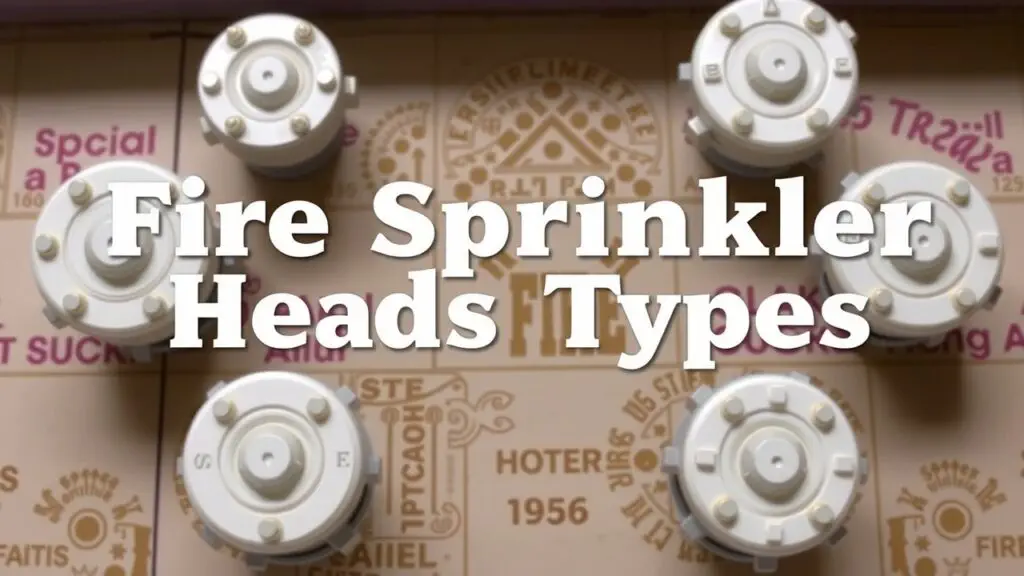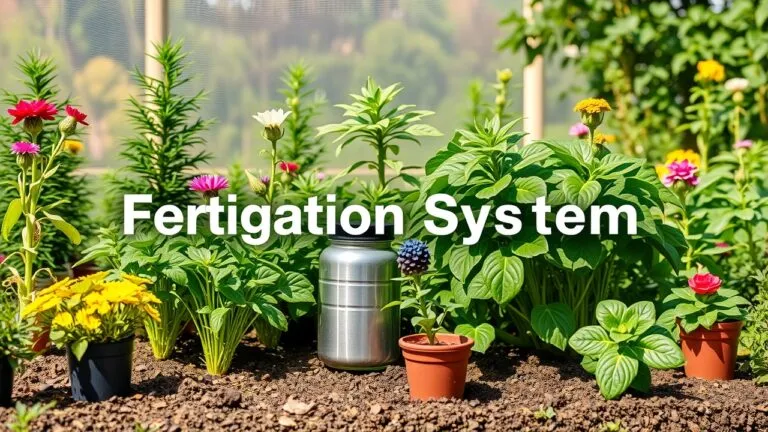Types of fire sprinkler heads vary greatly depending on the application. This guide covers wet pipe, dry pipe, and other sprinkler head types, explaining their uses in fire sprinkler systems for homes and businesses.
What Are Fire Sprinkler Heads?

Fire sprinkler heads play a key role in fire suppression systems. They help detect and extinguish fires by releasing water when they sense heat. Knowing how they work is important for keeping spaces safe from fire hazards.
Overview of How Sprinkler Heads Work
Sprinkler heads respond to temperature changes using different mechanisms. Commonly, they use either a glass bulb filled with liquid or a fusible metal link that melts when it gets too hot. When these components hit their activation temperature due to flames, they release water to control the fire.
| Mechanism | Description |
|---|---|
| Glass Bulb | A glass bulb has glycerin inside. It expands and breaks at high temps, activating the head. |
| Fusible Link | This is a metal piece that melts when it gets hot, allowing water to flow once it melts. |
Why Is It Important to Understand Different Types of Fire Sprinkler Heads?
Knowing about the different types of fire sprinkler heads matters a lot for better performance in various places. Each type comes with special features that fit certain situations; picking the right one can really improve firefighting efforts and cut down on damage.
Impact on Fire Protection Efficiency Based on Application Type
Different places like homes and businesses need different sprinkler designs:
- Residential areas often use concealed or pendant designs.
- Commercial spaces usually go for upright or sidewall options for higher ceilings.
- Industrial locations may need special systems like ESFR (Early Suppression Fast Response) sprinklers because of high storage risks.
Consequences of Incorrect Selection
Choosing the wrong type of sprinkler head can lead to big problems during a fire. It might not suppress the fire effectively, which can endanger lives and cause serious property loss. Learning about each type’s benefits helps avoid costly mistakes. Following NFPA standards also helps meet safety rules.
Main Types of Fire Sprinkler Heads Explained
Upright Sprinkler Heads
Upright sprinkler heads are designed to be installed above the ceiling. Their unique structure allows them to spray water downward. This type has a vertical shape and a deflector that spreads water effectively over an area. They work well in places where debris won’t block the water flow.
Applications
These sprinkler heads are commonly found in warehouses, industrial sites, and high-rise buildings with open ceilings. Their downward spray is great for large spaces where other types may not cover well.
Advantages
One big benefit of upright sprinklers is that they resist debris buildup. This keeps them working well when it counts. Plus, they are often more affordable to install and maintain. These advantages make upright sprinklers effective during fire emergencies.
Pendant Sprinkler Heads
Pendant sprinkler heads hang from the ceiling and spray water downwards. This design helps cover larger areas without being blocked by furniture or equipment below.
Applications
You’ll find these sprinklers in high-ceiling spaces like offices and residential buildings. They provide solid fire protection while keeping the look of the space nice.
Variations
There are different kinds of pendant designs. Standard pendant models stick out from the ceiling, while recessed or flush-mounted types fit right into the ceiling for a more discreet look.
Sidewall Sprinkler Heads
Sidewall sprinkler heads shoot water along walls instead of straight down from above. This feature makes them useful in narrow spots like hallways where targeted fire protection is needed.
What Are Sidewall Sprinklers Used For?
They’re perfect for covering long stretches of hallway walls, making sure tight areas get enough protection without needing lots of overhead units.
Concealed Fire Sprinkler Heads
Concealed fire sprinkler heads blend into ceilings more than standard ones do. They offer an appealing look while still providing safety features.
Their main perk is that they don’t stand out until they need to work. When there’s a fire, they quickly spray water but stay hidden at all other times.
Applications
These sprinklers are great for both commercial and residential spaces—perfect for hotels or fancy apartments where looks matter alongside safety. However, there are some downsides like harder access for maintenance compared to exposed models.
Early Suppression Fast Response (ESFR) Sprinkler Heads
Early Suppression Fast Response (ESFR) sprinkler heads are made for places that have high risks, like warehouses with high-piled storage. They are built to release water quickly, which helps put out fires before they spread. This is different from standard sprinklers that might take longer to respond. ESFR sprinklers can deliver a lot of water right where it’s needed, making them very effective.
These sprinklers are commonly used in warehouses and distribution centers where items are stacked high. Their fast response is key to stopping fires early and saving valuable goods and ensuring worker safety.
The way ESFR systems work is simple yet clever. They have heat-sensitive parts that react fast when temperatures rise due to fire. When it hits a set level—usually between 135°F and 165°F—the sprinkler goes off, spraying water right over the flames. This quick action is important for keeping damage to a minimum.
While ESFR sprinklers have many benefits, like using water efficiently and covering tricky areas well, they do have some downsides. For example, they might not work as well in spaces with many obstacles or when not designed properly for certain buildings. Plus, because they let out more water than typical sprinklers when they activate, places with these systems need good drainage plans.
Deluge Sprinkler Heads
Deluge sprinkler heads are different from other types because all the nozzles spray water at the same time when activated. This makes them perfect for protecting high-risk areas where fires can spread fast.
You often find deluge systems in chemical plants or places that store flammable materials. These environments need quick coverage against large fires, and the all-at-once operation helps achieve this without delay.
When it comes to how deluge systems activate, they use several methods like smoke detectors or manual alarms. Once triggered, all connected nozzles start spraying water immediately across a wide area. While this provides great coverage, it can also cause too much water discharge if not carefully controlled.
The main plus of deluge sprinklers is their ability to release a large volume of water quickly during emergencies. However, this can lead to flooding issues in delicate areas if not managed well.
Water Spray Heads
Water spray heads are made to reduce damage while cooling down equipment that may get too hot during electrical failures or small fires. They usually come with adjustable spray patterns so users can customize them for specific needs.
These heads are useful in places where sensitive equipment needs protection—like data centers or labs dealing with dangerous materials. Standard firefighting methods might not work as well here.
Spray patterns can vary widely—some create fine misting sprays suitable for fragile electronics while others cover bigger areas efficiently based on what’s needed at the moment.
The good thing about these spray heads is their effectiveness at minimizing damage from excess moisture while improving safety measures. Yet, challenges may arise in ensuring that each unit has enough reach so every area gets proper protection despite varying distances within the workspace.
Other Specialized Heads
Several types of specialized sprinkler heads cater to specific needs:
- Quick Response Sprinklers: Designed for homes and offer faster activation compared to regular models.
- Standard Response Sprinklers: Used widely in commercial buildings that have medium hazard levels.
- Extended Coverage Sprinklers: Require less space between installations but still perform effectively.
- Residential Fire Sprinkle Types: Focused on home use but still ensure good protection alongside style.
- Dry Pipe Sprinkle Systems: Great for unheated spaces where freezing could damage pipes filled with water.
Each type has its own special features and works best in certain settings depending on what’s required for safety and efficiency.
Sprinkler Head Components and Operation
Internal Components
Fire sprinkler heads have key internal parts that work together during a fire. The sealing assembly is really important. It stops water from flowing out until the system is activated. This assembly usually has a plug or cap that holds back the water supply. This way, sprinklers stay off until they are needed.
Heat-sensitive elements help detect increases in temperature. There are two common types: glass bulbs and fusible links. Glass bulbs have liquid inside that expands when heated. When it gets hot enough, the bulb shatters. Fusible links are metal pieces held together by a special low-melting-point alloy that melts under heat. These mechanisms let the sprinkler head turn on quickly when temperatures go up.
Deflectors are also important in fire sprinkler heads. They spread water over a wide area during a fire, which helps cover more space and reduces damage from flames or smoke. Deflectors direct water downward and outward, making fire suppression efforts more effective.
Activation Mechanisms
Different fire sprinklers have various activation methods, mainly focusing on thermal activation and system-wide activation. Thermal activation uses heat-sensitive elements, like glass bulbs or fusible links, to activate each individual sprinkler head when high temperatures occur.
Standard response sprinklers activate at certain temperature levels, usually around 155°F (68°C). Quick response sprinklers are designed to react faster, making them great for areas with higher risks like commercial kitchens or storage rooms.
On the other hand, deluge systems use system-wide activation. Here, all connected sprinkler heads go off at once when heat or smoke is detected by special detectors. This method works well in places with serious hazards that need quick action.
Temperature Ratings and Color Coding
Temperature ratings are important because they help determine how fast each type of fire sprinkler head activates based on different conditions. Common ratings include 135°F (57°C), 155°F (68°C), and 175°F (79°C).
Color coding systems show which temperature ratings match each sprinkler head:
- Red for an activation temperature around 135°F.
- Orange for approximately 155°F.
- Yellow for about 175°F.
This color coding helps professionals quickly identify the right sprinkler heads based on the hazard levels in buildings. It ensures safety standards are met while optimizing protection against fires.
Fire Sprinkler Head Selection Guide: Key Considerations
Choosing the right fire sprinkler heads is super important for keeping spaces safe from fires. Several things matter when picking the right type. These include the kind of place, risk level, ceiling height, looks, and following NFPA 13 standards.
Occupancy Classification
Occupancy classification means looking at what a building is used for. This helps in finding out which sprinklers are best to use.
- Residential Spaces: For homes and apartments, we usually go for residential fire sprinkler heads. They often hide in the ceilings so they look nice and neat.
- Commercial Buildings: In offices and stores where lots of people work and shop, commercial fire sprinkler heads need to cover bigger areas while still following local laws.
- Industrial Facilities: In places like factories where things can be risky, special industrial fire sprinkler heads are needed because they deal with flammable materials or machinery.
Each of these has different needs that affect how water sprays out and how well it works to protect people and property.
Hazard Classification
Hazard classification helps us see how risky a space is regarding fires:
- Light Hazard Classification: This is found in places like offices or schools where there aren’t many flammable things around; normal spray sprinklers work fine here.
- Ordinary Hazard Classification: Common in warehouses or factories with some combustibles; stronger systems may be necessary here.
- Extra Hazard Classification: Seen in places like chemical plants where there are many flammable substances; specialized systems with more water might be needed.
Knowing these classes helps choose the right sprinkle head types and how many are needed for safety.
Ceiling Height
Ceiling height really matters when deciding between upright and pendant sprinkle designs:
- Upright Sprinklers: Best for high ceilings (usually over 12 feet), they spray water up first before it falls down.
- Pendant Sprinklers: Great for lower ceilings (under 12 feet), they hang down from the ceiling and cover a specific area directly.
Picking the right type based on ceiling height makes sprinklers work better to put out fires and keeps everyone safe.
Aesthetic Considerations
The look of sprinklers can change how they fit into a room:
- Exposed Heads: These are easy to see but might not match your interior design very well, even though they work great.
- Concealed Heads: These hide away until they’re needed; they keep the ceiling looking good while still being safe.
Thinking about how each choice affects your space helps homeowners or business owners find a balance between safety and style.
Installation and Maintenance
Professional Installation
For fire sprinkler installation, hiring certified technicians is very important. These experts know how to design and install automatic fire sprinklers correctly. Proper installation keeps everyone safe and meets local building codes and standards. Following these guidelines helps avoid costly mistakes that can lead to system failures in emergencies.
Repair and Replacement
Knowing when to replace sprinkler heads can make a big difference in safety. Signs like visible rust or any kind of damage mean it’s time for action. If problems are found during inspections, starting the repair process quickly is essential for ongoing fire protection.
The replacement process usually involves shutting off the water supply first. After that, damaged heads are carefully removed, and new ones are installed according to the manufacturer’s instructions. Also, checking parts like sealing assemblies and heat-sensitive elements regularly helps keep everything working well over time.
FAQs About Fire Sprinkler Heads
What are the main types of fire sprinkler heads?
The main types include upright, pendant, sidewall, concealed, ESFR, and deluge sprinklers. Each serves a unique purpose in fire protection.
How do temperature ratings affect sprinkler head activation?
Temperature ratings determine when a sprinkler activates. Common ratings include 135°F, 155°F, and 175°F. Higher temperatures require different types of heads.
What factors should I consider when selecting fire sprinkler heads?
Consider the building type, occupancy classification, hazard classification, ceiling height, and aesthetic preferences. These factors influence effectiveness.
What is the difference between quick response and standard response sprinklers?
Quick response sprinklers activate at lower temperatures. Standard response sprinklers have a higher activation temperature and take longer to respond.
How do deflector designs impact water distribution?
Deflector designs affect how water spreads during activation. Conical patterns provide focused sprays. Dome-shaped patterns cover larger areas.
Key Fire Sprinkler Components
- Sealing Assembly: Prevents water flow until activation.
- Heat-Sensitive Element: Activates based on temperature changes.
- Glass Bulb: Contains glycerin that expands and breaks under heat.
- Fusible Link: Melts under high heat to release water.
- Sprinkler Head Escutcheon: Hides the mounting hardware for aesthetic purposes.
Fire Sprinkler Design Considerations
Sprinkler Head Types:
- Pendant
- Upright
- Sidewall
- Concealed
- Recessed
Fire Sprinkler Patterns:
- Conical spray pattern focuses water.
- Dome-shaped spray pattern covers large areas.
- Crescent-shaped spray pattern provides targeted coverage.
Maintenance and Inspection Tips
- Conduct regular inspections every six months or annually.
- Look for signs of damage such as rust or leaks.
- Follow NFPA guidelines for repairs or replacements.
Related Topics
- Types of Fire Sprinkler Systems
- Types of Sprinkler Head Activation
- Types of Sprinkler Spray Patterns
- Types of Sprinkler Head Applications
- Types of Hazard Classifications (for Sprinklers)
- Types of Occupancy Classifications (for Sprinklers)
- Types of Sprinkler Head Installation Methods
- Types of Sprinkler Head Maintenance Procedures
- Types of Fire Sprinkler Inspection Requirements



Types of Fire Sprinkler Heads: A Complete Guide to Sprinkler Systems